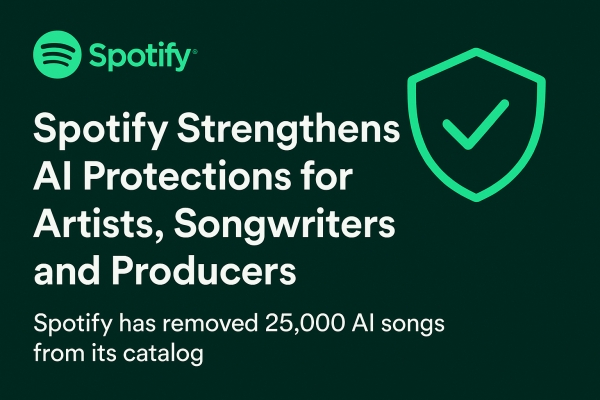Spotify Strengthens AI Protections for Artists, Songwriters, and Producers
In September 2025, Spotify made a big move in shaping the future of music streaming and AI: announcing new policies and tools designed to protect artists, songwriters, and producers from misuse of generative AI — especially voice clones, spam uploads, and deceptive content. These changes reflect growing concern across the music industry about how AI could erode creators’ rights, mislead listeners, and dilute earnings. Here’s a deep dive into what Spotify is doing, what prompted the change, what it means, and what still remains uncertain.
What prompted Spotify’s shift
Generative AI tools have rapidly become more powerful and accessible. They can produce vocals that mimic real artists, churn out instrumentals, and mass-produce tracks with minimal human input. While many artists and producers are experimenting and innovating with AI — from songwriting assistive tools to AI-powered instrumentation — there’s also been a rise in:
-
Spammy content: mass uploads of tracks that are very short, duplicated, or manipulated in trivial ways, often aimed at exploiting streaming thresholds or algorithms.
-
Impersonation/deepfakes: using AI to clone or mimic the voices of well-known artists (without authorization), uploading tracks under another artist’s name, or otherwise confusing attribution.
-
Opacity/transparency issues: listeners and rights holders not always knowing whether AI was used (and how), making it harder to assess origin, value, and legitimacy.
These trends have a number of potential negative effects: diluting royalty pools, hurting authentic artists who compete for listener attention, undermining trust, and possibly misappropriating voices and identities.
Spotify itself has observed these challenges. Over the past year, the company reported that it removed 75 million “spammy” tracks from its platform. Spotify+2Music Business Worldwide+2
What Spotify is doing: The New Protections
Spotify’s announcement lays out a three-pronged framework aimed at combating the worst abuses, while allowing responsible AI use. The Hollywood Reporter+3Spotify+3Consequence+3
Here are the main pillars:
1. Stronger impersonation rules
-
Unauthorized vocal impersonation or voice cloning will no longer be tolerated unless the artist whose voice is being used explicitly authorizes it. Spotify+2Music Business Worldwide+2
-
Spotify is also improving its process for detecting “content mismatch” — when someone uploads music (AI-generated or otherwise) to another artist’s profile or tries to pass off content under the wrong name. They are reducing review wait times and enabling artists to flag mismatches even before release stages. Spotify+1
2. Music spam filter
-
A new spam filtering system will identify and flag tracks and uploaders engaging in abuses like mass uploads, duplicate tracks (with slightly changed metadata), SEO manipulation, or uploading very short tracks just to hit royalty thresholds. Spotify+2Music Business Worldwide+2
-
The system will also stop recommending such tracks via Spotify’s algorithms, so they have less visibility. Rollout is planned carefully so as not to unduly penalize legitimate creators. Spotify+1
3. AI disclosures through industry-standard credits
-
Spotify is backing work by DDEX (Digital Data Exchange) to develop metadata standards that allow artists and rights holders to disclose how AI was involved in the creation of a track (e.g. vocals, instrumentation, mixing, mastering). Spotify+1
-
These disclosures will become visible in the Spotify app once submitted via labels/distributors. The goal is transparency, not penalizing artists who responsibly use AI. Spotify+1
What hasn’t happened (or what may be misunderstood)
There’s been some confusion, and it’s important to correct or clarify:
-
Despite some reports, Spotify has not said it removed 25,000 AI-songs. What they have said is 75 million “spammy” tracks have been taken down in the past year. Spotify+2Music Business Worldwide+2
-
Spotify is not banning AI music altogether. The policy changes are about misuse: impersonation without authorization, deceptive claims, spam tactics. Legitimate, transparent uses of AI are allowed and can even be declared in the credits. Rolling Stone+2Spotify+2
-
Spotify does not own AI-generated music or create its own tracks; its role is as a platform. The royalty mechanism and licensing remain based on what uploaded / licensed content is used, as always. Spotify+1
Impacts on Stakeholders
These policy changes have implications across the industry — for artists, songwriters, producers, platforms, listeners, and AI tool developers.
For artists, songwriters, producers
-
Stronger protection of identity: Artists who are concerned their voice could be misused now have clearer recourse.
-
Greater ability to benefit from transparency: If they use AI tools as part of their production, they can be clear with fans—this can help maintain trust.
-
Reduced competition from shady spam: Fewer low-effort or deceptive uploads may mean better discoverability and potentially less dilution of streaming royalty pools.
For streaming platforms and distributors
-
Need to build or upgrade detection and review systems: both for content mismatch/impersonation and for spam detection.
-
More cooperation with metadata standards bodies and distributors (labels, aggregators) to ensure AI credits/disclosures are supported.
For listeners
-
Better trust and clarity: listeners will have more information about how a track was made and whether an artist authorized certain uses.
-
Possibly higher quality of recommended content, fewer spammy or misleading tracks.
For AI & tech developers
-
More incentive to build tools that respect voice rights, transparency, and ethics.
-
Potentially more requirements from distributors/streaming services to provide metadata on how AI was used.
Critiques, challenges, and what to watch
While Spotify’s announcement is a strong step, there are open questions and challenges ahead. Here are several:
-
Implementation & errors
Designing spam filters, detecting deepfakes, impersonation, and content mismatch is hard. False positives (legitimate tracks flagged) and false negatives (bad content slipping through) are risks. Spotify acknowledges it will roll out the filter conservatively to avoid penalizing the wrong creators. Spotify+1 -
Definition & limits of “spammy” / “slop” content
What counts as abuse, and what counts as creative experimentation or low-budget DIY content? There’s a fine line. Some artists may use AI in light or experimental ways that border on the edge. The clarity of definitions, fairness of enforcement, and transparency will matter. -
Global enforcement & jurisdictional issues
Artists around the world operate under different copyright laws, cultural norms, and data protection regimes. Ensuring consistent protection globally is challenging. -
Disclosure norms & audience reception
Even when disclosed, how will listeners respond? Will AI-involved tracks be stigmatized, under-promoted, or unfairly judged? Having right to disclose is good, but audience perception and industry reaction will matter. -
Long-term business models and royalty fairness
If a track uses AI, how is ownership or authorship assigned? How are royalties divided among human creators vs AI tool developers? Spotify’s policy seems to focus more on preventing misuse than laying out full new rules for attribution/royalties in mixed human/AI creation. That is, for now, still murky. -
Transparency of enforcement
How much will creators see about the reason tracks are removed, flagged, or demoted? Will there be appeals? How accessible will the policy documents be? How often will they be updated?
Why this matters
These changes are not just technical tweaks; they reflect deeper tensions and values in how music will be created, shared, and consumed in an age of AI. Here’s why the Spotify move is significant:
-
Artist rights & identity: Voices are deeply personal; misuse (voice cloning, impersonation) is an ethical violation, not just a legal one. Empowering creators to control when their voice is used is essential.
-
Economic integrity: Streaming platforms pay out royalties based on volume of plays, but royalty pools and user attention are finite. Spam or deceptive content that gains traction can dilute earnings for legitimate creators.
-
Trust & platform reputation: If users feel tricked by AI deepfakes, fake artists, or spam, trust may erode. Platforms that fail to police this risk losing user and artist confidence.
-
Shaping ethical norms: As AI tools proliferate, early policies like Spotify’s help set industry expectations for transparency, attribution, voice rights, and fairness.
What’s next / What to Monitor
Here are some things to watch, both for creators and industry observers:
-
How fast the spam filter is fully rolled out, and how accurate it is in practice.
-
Whether major record labels and distributors adopt the DDEX AI credit standard broadly, and how detailed those disclosures are.
-
How Spotify responds to cases of false positives: artists who are wrongly flagged, or content improperly removed.
-
Legal/regulatory moves: voice rights legislation, copyright laws being updated to explicitly address AI-created content or impersonation, potentially in different countries.
-
How other platforms respond: Spotify is not alone — YouTube, Apple Music, Amazon, TikTok, etc., will likely feel pressure to adopt similar policies, especially as artist backlash or public concern grows.
-
How producers and artists adapt: will we see more contracts about AI use, more artist-driven tools, or new genres of hybrid human-AI music with clear disclosure?
Conclusion
Spotify’s new policy shift represents a major juncture in the streaming and music creation landscape. By strengthening impersonation rules, deploying spam filters, and pushing for AI credit disclosures, Spotify is attempting to strike a balance: enabling innovation while protecting creators from abuse. For artists, producers, and songwriters, the changes provide more control, transparency, and potentially a fairer environment. Yet much will depend on the policy implementation, the evolution of enforcement, and how the broader ecosystem adapts — listeners, AI developers, distributors, law makers.



